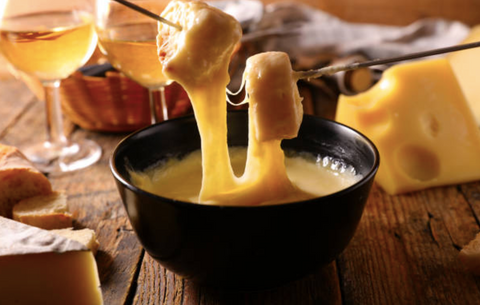A French steak is a thick-cut piece of meat typically used for grilling. The steak is cut from the tenderloin, a muscle that doesn't do much work, and therefore it is extra tender. It's also known as filet de Boeuf in France.
Making a French Steak Chips
A French steak Chips is a steak with some chips that has been rolled in butter and herbs. This adds a lot of flavor to the steak and makes it very aromatic and delicious. The French people have a name for this method called beurre maÎtre d'hôtel. You can also call it French butter because it sounds excellent.
- Get some good quality steaks, preferably sirloin, but ribeye would work too. I am using sirloin here, but you can use whatever you want, as long as it isn't too thin or thick. Of course, you can also use chicken or pork if you like.
- Chop up some garlic very finely and mix with softened butter. Add salt and pepper for seasoning. Mix well. You can also add herbs such as parsley or chives if you like.
- Roll the steak in the garlic butter until well coated on both sides and place in a baking dish with a lid or foil so that the steam doesn't escape while cooking (it will dry out your meat).

Cuts of French Steak
French steak is a cut of beef taken from the sirloin section of the cow carcass. It has three different names, depending on the part of Europe in which it is located. In Britain, it is called rump steak; in France, it is referred to as contre-filet; and in Germany, it is known as hüfte steak.
- French steak has relatively high-fat content and should be grilled or broiled at a high temperature for a short period to ensure that it does not become tough. It works well when served with roasted vegetables or fried potatoes.
Several cuts of French Steak Chips
There are several different cuts of steak in France, but they are not the same as they are in the UK.
- The most common steak cuts in French cuisine are rum steak (which is a top round cut), faux filet (a sirloin), and onglet (hanger steak).
- The onglet is among the most popular cuts of beef in France, though it has yet to catch on much outside of Europe.
- The faux filet is usually cut from the bottom sirloin, so it's relatively inexpensive. Sirloin, but tends to be leaner and have less fat marbling.
- The rumsteak is typically prepared by grilling or pan-frying and is served with some sort of sauce like béarnaise, bordelaise, or demi-glace. Because this cut is leaner than other steaks, it can be challenging if not cooked properly.
- The onglet is also known as butcher's steak because it was typically given to the butcher to take home rather than sold directly to customers. This cut has a distinctive taste that some describe as "gamey," while others call it "iron-rich." It can be tender.
Serving a French Steak Chips
The French eat beef raw, undercooked, and well done. Both beef tartare and beef carpaccio are popular dishes. Tartare is like a hamburger but chopped instead of ground, while carpaccio is very thinly sliced meat or fish. Steak tartare is a dish made from finely chopped raw meat or fish. It's usually served with onions, capers, and seasonings often presented to the diner separately for assembly at the table.
- Steak tartare is traditionally served rare, with raw egg yolk on top. It's often accompanied by raw onion slices, capers, and seasonings like Worcestershire sauce or Tabasco sauce. If it's made with fish rather than beef, it's called tataki (Japanese) or Crudo (Italian). Sometimes steak tartare is mixed with raw quail egg yolk.
- In France, steak tartare dates to the early 1900s. It was initially a way to tenderize tough cuts of meat by pounding them into submission. The dish gained popularity in Paris coffee shops in the 1930s.
- While the traditional recipe calls for raw meat or fish, you can also order a version that substitutes cooked steak for natural beef.
What the French eat with Steak?
The French are famous for their meat and potato dishes, but what exactly do they eat with steak?
You have many choices in France regarding side dishes or accompaniments. The most traditional way to serve steak is with fries (Pommes Frites), which is still a popular option today. You can also choose from other classic French side dishes such as boiled or steamed potatoes, green beans, or mushrooms. Today popular side dishes include rice, rice pasta, salads, and vegetables.
- Steakhouse restaurants in France usually offer a choice of more than one side dish, so you can match the style of food you like with the cut of meat you prefer. For example, if you are a fan of ribeye steaks, you might want to order one with Pommes Frites (French fries).
- On the other hand, if you prefer filet mignon (or fillet steak), try calling it with grilled vegetables and a salad on the side.
If you are having friends over for dinner and want to make an accurate impression on them, try serving your steak with French fries or grilled vegetables as an accompaniment. These classic choices are relatively easy to prepare at home and will undoubtedly impress your guests as a bonus.
What is Fillet Steak?
Fillet steak is the tenderest cut of beef. It was also expensive. In French, it's called filet mignon, and it's usually served in pretty thick slices.
Flank steak is what the French call bavette d'aloyau, although you don't often see this cut sold as a separate item in France.
Beef is usually cut into pieces similar to UK cuts, but not always under the same name. For example, the cuts of beef (and pork) used for grilling are the same in France and the UK — they're just called different things.
Very rare Steak
Rare steak is a good deal more challenging to cook than well-done steak. But, if you like your steak to have a nice red center, rare is the way to go. All it takes is a little bit of practice and some patience.
Before you begin:
- Make sure your steak is at room temperature.
- Heat a frying pan until it's boiling.
- Spray the steak with some cooking spray and put it in the pan for about two minutes on each side.
When removing the steak from the frying pan, let it sit for about five minutes before serving it. This will give its juices time to redistribute throughout the meat, ensuring that each bite will be extra tender and flavorful!
Doneness levels of Steak
There are four basic doneness levels for steaks and other meats: rare, medium-rare, medium and well done level.
- Rare: The steak is red and cool in the middle. It has not been seared at all. It looks the same as it did before it was cooked, except that it's now warm inside and charred on the outside.
- Medium-rare: The steak is a rosy pink with a warm center. Meat at this level of doneness is firm but tender and very juicy.
- Medium: The steak has pale pink centers that are warm to the touch. The meat has lost some of its juiciness but still tastes good.
- Well done: The steak is grayish-brown throughout, dried out, and chewy. Most Americans prefer their meat cooked to this level or beyond.
Eating a rare Steak
For most of us, eating meat means eating meat that has been cooked. But a subset of our population enjoys meat in its more raw form. The most common and popular form of this is sushi. But some want steak tartare and carpaccio.
- Rare steak is said to be tender, rich, and succulent. Some say it's the best way to eat steak. But, unfortunately, it's undoubtedly the most expensive way to eat it, too.
The question of whether a rare steak is healthy or not is often raised by concerned diners who have just ordered their porterhouse well-done -- or have had it sent back for the third time for further cooking.
The truth about rare steak is that it can be pretty safe to eat if the proper safety precautions are taken.
The main risk associated with eating rare steak comes from the bacteria E Coli, found on cattle hides during slaughter and in the intestines during processing. These bacteria can contaminate beef during processing, so it requires careful handling to ensure it doesn't end up in your meal.
Is rare Steak unhealthy?
Rare steak, seared on the outside and cool on the inside, will have an internal temperature of about 115 degrees. So it's safe to eat, but it won't offer you any nutritional value. On the other hand, Well-Done steak reaches an internal temperature of around 155 degrees, which can help kill bacteria.
- The difference between rare and well-done steak is how long it's been cooked. Rare steak typically takes about 5 or 6 minutes to cook. That's enough time to sear the outside but not cook through all the way. Well-done steak takes 10 to 12 minutes to cook through thoroughly.
- The color of a rare or well-done steak can differ depending on its fat content and marbling — cuts with more fat tend to render in their juices when cooked for longer.
Marbled meat also tends to brown faster than lean meat because of its higher fat content. But that doesn't mean your meat is better cooked (or rawer) if it's browner — it just means there are more fats present in that cut of meat.
Flank Steak in France
The flank steak is cut from the underbelly of the beef. It is a flavorful cut with moderate marbling, ideal for grilling. While it's not as tender as other cuts, it should be cooked to medium-rare and sliced thinly against the grain to maximize tenderness.
Popularity of Steak
The French are known for their love of food and their sophisticated palettes. The French people are said to appreciate a flavorful, well-seasoned meal more than simply filling. They take great care and pride in preparing their meals and usually sit down to eat together as a family.
- Steak is one of the most popular dishes in France, and many traditional steak recipes have been passed down through generations. It is prepared in various ways, but the standard cut used is called aloyau in French.
- This type of steak comes from the sirloin area of the cow's body. Its tenderness makes it ideal for cooking on a grill or barbecue.
Sauces for Steak
You have two questions here:
"What sauces are good with steak?" And "What are the classic French sauces?"
The first question is too broad for a single answer. The second is a little more manageable, and I'll try to cover some basics. There are several ways to classify French sauces, though no recipe fits neatly into one category. Here are some of the better-known ones.
Starting with the mother sauces:
Béchamel (white sauce) – Made by thickening milk with a roux (flour and fat). You've probably had this if you've ever had macaroni and cheese or lasagna. Gruyere cheese can be added to make Mornay sauce, often used on seafood dishes like lobster. Béchamel has many derivatives, including Nantua (crab), Cheddar, and soubise (onion).
Velouté - Thickened with a roux but made from a light stock rather than milk. Derivatives include Allemande (made from veal stock), Supreme (chicken stock), and Caucasian (fish stock).
Espagnole – Also known as brown sauce and made from beef stock thickened with a dark roux
The Two Most Important Things to Know About Steak
- The first thing you need to know about steak is that heat is your friend. Don't be scared of it. Get your pan hot, and then keep it burning. Don't worry about burning your steak; worry more about undercooking it or putting your mouth onto a piece of cold meat.
- The second most important thing you need to know is that steak needs time to relax after cooking. If you put your food straight onto a plate and try slicing into it immediately after it leaves the pan, all the juices will run out onto the plate, and that entire flavor will be lost forever.
In the best-case scenario, you'll have dry steak. Worst-case scenario, your knife will glide straight through your meat like butter, and everything will fall apart before you even get to taste it! So once you've cooked your steak.

![French Steak Frites [Including The Two Most Important Things You Must Know]](http://monpanierlatin.co.uk/cdn/shop/articles/Capture_d_ecran_2022-03-11_a_15.15.05_1280x.png?v=1647011831)


